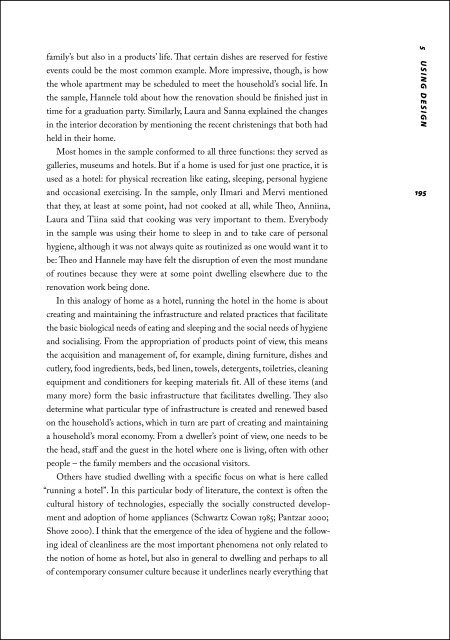Lataa ilmaiseksi
Lataa ilmaiseksi
Lataa ilmaiseksi
You also want an ePaper? Increase the reach of your titles
YUMPU automatically turns print PDFs into web optimized ePapers that Google loves.
family’s but also in a products’ life. That certain dishes are reserved for festive<br />
events could be the most common example. More impressive, though, is how<br />
the whole apartment may be scheduled to meet the household’s social life. In<br />
the sample, Hannele told about how the renovation should be finished just in<br />
time for a graduation party. Similarly, Laura and Sanna explained the changes<br />
in the interior decoration by mentioning the recent christenings that both had<br />
held in their home.<br />
Most homes in the sample conformed to all three functions: they served as<br />
galleries, museums and hotels. But if a home is used for just one practice, it is<br />
used as a hotel: for physical recreation like eating, sleeping, personal hygiene<br />
and occasional exercising. In the sample, only Ilmari and Mervi mentioned<br />
that they, at least at some point, had not cooked at all, while Theo, Anniina,<br />
Laura and Tiina said that cooking was very important to them. Everybody<br />
in the sample was using their home to sleep in and to take care of personal<br />
hygiene, although it was not always quite as routinized as one would want it to<br />
be: Theo and Hannele may have felt the disruption of even the most mundane<br />
of routines because they were at some point dwelling elsewhere due to the<br />
renovation work being done.<br />
In this analogy of home as a hotel, running the hotel in the home is about<br />
creating and maintaining the infrastructure and related practices that facilitate<br />
the basic biological needs of eating and sleeping and the social needs of hygiene<br />
and socialising. From the appropriation of products point of view, this means<br />
the acquisition and management of, for example, dining furniture, dishes and<br />
cutlery, food ingredients, beds, bed linen, towels, detergents, toiletries, cleaning<br />
equipment and conditioners for keeping materials fit. All of these items (and<br />
many more) form the basic infrastructure that facilitates dwelling. They also<br />
determine what particular type of infrastructure is created and renewed based<br />
on the household’s actions, which in turn are part of creating and maintaining<br />
a household’s moral economy. From a dweller’s point of view, one needs to be<br />
the head, staff and the guest in the hotel where one is living, often with other<br />
people – the family members and the occasional visitors.<br />
Others have studied dwelling with a specific focus on what is here called<br />
“running a hotel”. In this particular body of literature, the context is often the<br />
cultural history of technologies, especially the socially constructed development<br />
and adoption of home appliances (Schwartz Cowan 1985; Pantzar 2000;<br />
Shove 2000). I think that the emergence of the idea of hygiene and the following<br />
ideal of cleanliness are the most important phenomena not only related to<br />
the notion of home as hotel, but also in general to dwelling and perhaps to all<br />
of contemporary consumer culture because it underlines nearly everything that<br />
5 U S I N G D E S I G N<br />
195
















